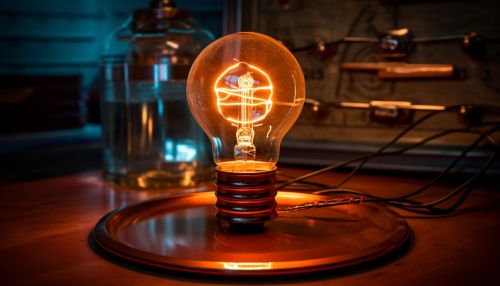Electric circuit
Introduction
An electric circuit is a path in which electrons from a voltage or current source flow. The point where those electrons enter an electrical circuit is called the "source" of electrons. The point where the electrons leave an electrical circuit is called the "return" or "earth ground". The exit point is called the "return" because electrons always end up at the source when they complete the path of an electrical circuit.


Components of an Electric Circuit
An electric circuit is composed of individual electrical components such as resistors, inductors, capacitors, transmission lines, and transistors connected by conductive wires or traces through which electric current can flow.
Power Source
The power source is the component that provides the voltage and current in an electric circuit. This could be a battery, a power supply unit, or an electrical generator.
Load
The load in an electric circuit is the component that consumes the power provided by the power source and converts it into other forms of energy such as heat, light, or motion. Examples of loads include light bulbs, motors, and electronic devices.
Conductors
Conductors are materials that allow electric current to flow through them with little resistance. In an electric circuit, conductors are usually metallic wires that connect the power source to the load.
Switch
A switch is a device that can interrupt the flow of electric current in a circuit. It allows control over the operation of the circuit by turning the current flow on and off.
Types of Electric Circuits
Electric circuits can be categorized into several types based on different factors such as the type of current, the configuration of components, and the power source used.
Series Circuits
In a series circuit, all components are connected end-to-end to form a single path for the electric current. This means that the current is the same through all components, but the voltage across each component can be different.
Parallel Circuits
In a parallel circuit, all components are connected across each other, forming exactly two sets of electrically common points. This means that the voltage across each component is the same, but the current through each component can be different.
Mixed Circuits
A mixed circuit (also known as a compound circuit) is a combination of series and parallel circuits. In a mixed circuit, some components are connected in series while others are connected in parallel.
Electric Circuit Analysis
Electric circuit analysis is the process of calculating the voltages, currents, and power in an electric circuit. This involves applying the laws of physics, particularly Ohm's law and Kirchhoff's laws, to the circuit.
Ohm's Law
Ohm's law states that the current through a conductor between two points is directly proportional to the voltage across the two points, and inversely proportional to the resistance between them.
Kirchhoff's Laws
Kirchhoff's laws are two equalities that deal with the conservation of charge and energy in electrical circuits. Kirchhoff's current law (KCL) states that the sum of currents entering a junction in a circuit must equal the sum of currents leaving the junction. Kirchhoff's voltage law (KVL) states that the sum of the electromotive forces in any closed loop or mesh in a network is equal to the sum of the potential drops in that loop.
Applications of Electric Circuits
Electric circuits are fundamental to modern technology and are used in a wide variety of applications, from simple devices like flashlights and doorbells to complex systems like computers and telecommunications networks.
Electronics
In electronics, electric circuits are used to process and manipulate signals. This includes amplifying signals, filtering signals, and converting signals from one form to another.
Electrical Power Systems
In electrical power systems, electric circuits are used to generate, transmit, and distribute electrical power. This includes power generation systems, transmission lines, and distribution networks.
Control Systems
In control systems, electric circuits are used to control the behavior of other systems. This includes feedback control systems, automation systems, and robotics.
